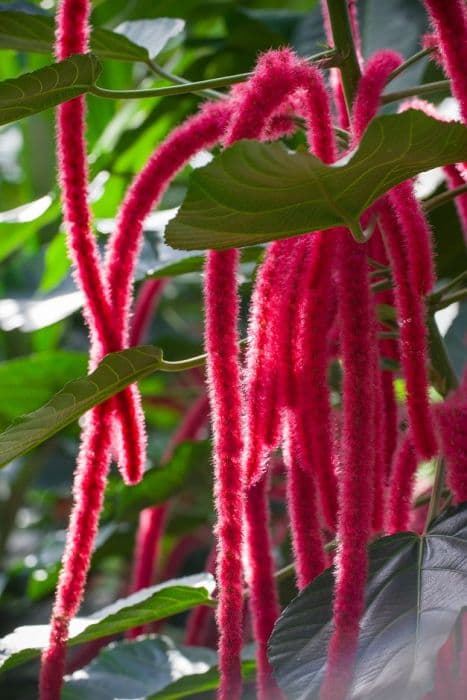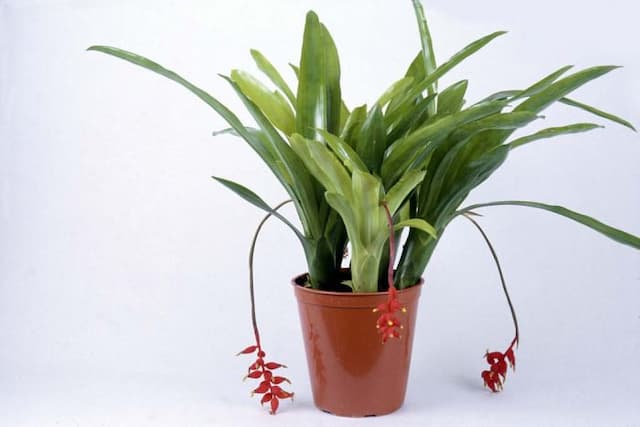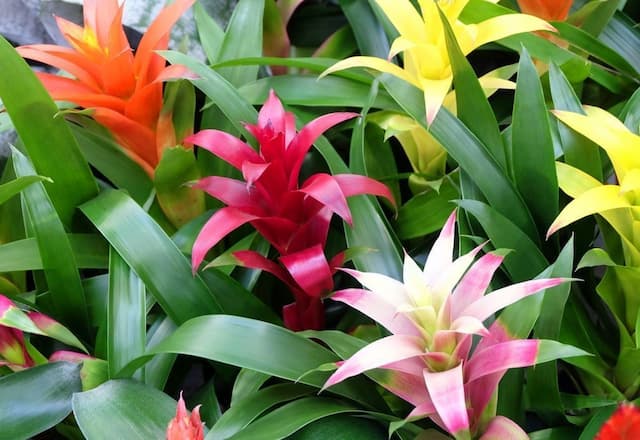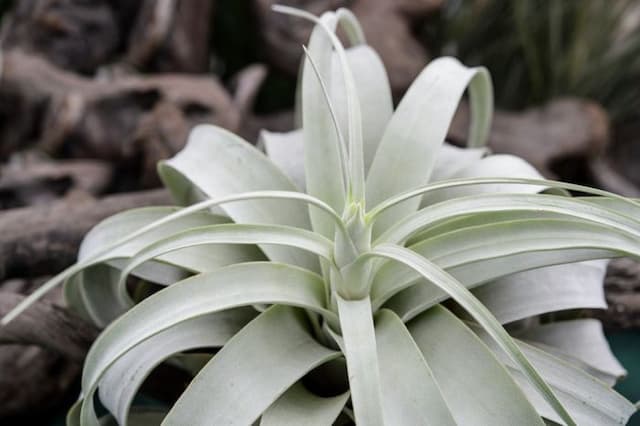Puya Puya laxa

ABOUT
The Puya laxa, commonly known as the Puya plant, is a striking and unusual species with a distinctly architectural form. Its appearance is characterized by a rosette of narrow, tough, and leathery leaves, which are typically arranged in a spiralling pattern. The leaves are typically green, though they may have a silvery or bluish tinge that adds to the visual interest of the plant. Each leaf comes to a sharp point at its end and often bears small teeth along the edges, giving them a serrated look. This plant is known for its remarkable flower spike, where the blossoms are borne on a tall, sturdy stalk that emerges from the center of the leaf rosette. The flowers of Puya laxa usually come in stunning shades of blue, green, purple, or violet, often with contrasting orange or yellow anthers that add a dash of color to the already vibrant display. The overall aesthetic is exotic and eye-catching, making this plant a focal point in the landscapes where it is typically found or cultivated. The Puya laxa is also noteworthy for its hardiness, capable of surviving in tough environmental conditions with minimal care once established. The tough leaves and flower spike give the plant a rugged, yet elegant appearance that attracts not only the eyes of plant enthusiasts but also pollinators in its natural habitat. Despite its ornamental features, it maintains a sense of wildness, reminiscent of its origins in rugged terrains. Overall, the Puya laxa is a majestic and durable plant celebrated for its aesthetic appeal and distinctive floral display.
About this plant
 Names
NamesFamily
Bromeliaceae
Synonyms
Puya Laxa
Common names
Puya laxa
 Toxicity
ToxicityTo humans
Puya laxa, also known as Queen of the Andes, does not have a well-documented profile of toxicity to humans. There is no widespread information that suggests that Puya laxa is poisonous or causes symptoms of poisoning when touched or ingested. However, it is always prudent to exercise caution and avoid ingesting plants that are not known to be safe or that are not commonly used for culinary purposes.
To pets
Similar to its effects on humans, there is no specific information indicating that Puya laxa, or Queen of the Andes, is toxic to pets. There are no well-documented cases of poisoning in animals from ingestion of this plant. As with humans, pet owners should prevent their animals from eating ornamental plants as they can sometimes cause mild stomach upset purely due to their non-dietary nature.
 Characteristics
CharacteristicsLife cycle
Perennials
Foliage type
Evergreen
Color of leaves
Green
Flower color
Greenish-yellow
Height
2 feet (0.61 meters)
Spread
2 feet (0.61 meters)
Plant type
Bromeliad
Hardiness zones
9
Native area
South America
Benefits
 General Benefits
General Benefits- Ornamental Value: Puya laxa, often known as Queen of the Andes, adds aesthetic appeal to gardens with its striking greenish-yellow flowers and rosette of spiky leaves.
- Drought Tolerance: This plant is highly adapted to dry conditions, making it an excellent choice for xeriscaping and water-wise gardening.
- Habitat for Wildlife: It provides nectar and pollen for birds, particularly hummingbirds, which play a role in pollination.
- Low Maintenance: Once established, Puya laxa requires minimal care, making it suitable for gardeners seeking low-maintenance plants.
- Soil Erosion Control: Its root system can help stabilize soil, reducing erosion on slopes and in areas with loose soil.
- Uniqueness: With its unique appearance and infrequent bloom cycle, the plant can be a conversation starter and educational interest in botanical gardens and amongst plant enthusiasts.
- Adaptability: Puya laxa can adapt to a range of soil types as long as they drain well, offering flexibility in garden design.
 Medical Properties
Medical PropertiesThis plant is not used for medical purposes.
 Air-purifying Qualities
Air-purifying QualitiesThis plant is not specifically known for air purifying qualities.
 Other Uses
Other Uses- Ornamental Display: Puya laxa, often admired for its unique appearance, can be cultivated in gardens or landscapes as a feature plant to add an unusual visual interest.
- Craft Material: The fibrous leaves of the Puya laxa can be dried and used in crafting for decorative purposes, such as in making woven baskets or textiles.
- Culinary Use: Although not widespread, some cultures might use the nectar contained within the flowers of Puya laxa as a sweet additive to various dishes or beverages.
- Education and Research: Puya laxa can be used in educational settings to study plant adaptability and survival strategies in harsh conditions, given its native growth in rocky terrains.
- Erosion Control: Planting Puya laxa in areas prone to erosion can aid in soil stabilization due to its root system that can help to hold the soil together.
- Photography and Art: Its striking form and color can make Puya laxa a subject of interest for photographers and artists, capturing its beauty through various mediums.
- Habitat Restoration: Puya laxa can be used in restoration projects to reestablish native vegetation and support local wildlife that depends on it, within its natural habitat range.
- Living Fences: In some regions, Puya laxa might be planted in rows to develop into natural barriers or living fences due to their size and structural form.
- Hummingbird Attraction: The flowers of Puya laxa can be used to attract hummingbirds, providing them with a natural source of nectar and enhancing biodiversity in the area.
- Symbolic Plant: In certain cultures, Puya laxa could be used symbolically in ceremonies or as a representation of resilience given its ability to thrive in tough environments.
Interesting Facts
 Feng Shui
Feng ShuiThe Puya laxa is not used in Feng Shui practice.
 Zodiac Sign Compitability
Zodiac Sign CompitabilityThe Puya laxa is not used in astrology practice.
 Plant Symbolism
Plant Symbolism- Persistence: Puya laxa, also known as Queen of the Andes, is known for its resilience and ability to grow in harsh conditions, symbolizing determination and the ability to endure challenging environments.
- Rarity and Uniqueness: Given its unique appearance and uncommon nature, this plant represents the beauty in rarity and the value of being one-of-a-kind.
- Adaptation: This plant has evolved to survive in specific ecosystems, which signifies the importance of adaptability and finding one's niche to thrive.
- Patience: The Queen of the Andes can take many years to bloom, symbolizing patience and the reward of waiting for the right moment to shine.
- Protection: With its sharp leaves, Puya laxa also signifies protection and the need to guard oneself from external threats.
 Water
WaterQueen-of-the-Andes (Puya laxa) prefers consistent moisture but does not like to be waterlogged, so it's essential to provide well-draining soil. During the active growing season in spring and summer, water the plant thoroughly when the top inch of the soil feels dry, approximately every 7 to 10 days, using about half a gallon of water each time, depending on the size of the plant and pot. In fall and winter, reduce watering to once every two to three weeks, allowing the soil to dry out slightly more between waterings. Always avoid letting the plant sit in standing water as this can cause root rot.
 Light
LightQueen-of-the-Andes thrives best in full sun to partial shade. Place the plant in a location where it can receive at least six hours of direct sunlight daily. An east or west-facing window is ideal if the plant is being grown indoors, while outdoors, a spot that receives bright morning light with some afternoon protection is optimal.
 Temperature
TemperatureThe Queen-of-the-Andes prefers a temperate climate with temperatures ranging between 50°F and 80°F. The plant can tolerate a minimum temperature of around 40°F; however, it should be protected from frost. Optimal growth occurs when the temperature is maintained within the 60°F to 75°F range.
 Pruning
PruningPruning the Queen-of-the-Andes is primarily for aesthetic purposes and to remove any dead or damaged leaves. Prune sparingly, as the plant grows slowly and does not produce excessive foliage. The best time for pruning is in the late winter or early spring before new growth begins. Pruning every couple of years is usually sufficient, focusing on maintaining the plant's shape and removing any unsightly or unhealthy parts.
 Cleaning
CleaningAs needed
 Soil
SoilPuya laxa, commonly referred to as Silver Puya, thrives best in a well-draining soil mix that is composed of equal parts sand, peat, and perlite or pumice, to enhance drainage and aeration. This bromeliad favors acidic to neutral soil, with an ideal pH range between 5.0 and 7.0.
 Repotting
RepottingSilver Puya should be repotted every few years, or when the plant has outgrown its current pot. It's suggested to repot Puya laxa approximately every 3 to 4 years to refresh the soil and provide room for root growth.
 Humidity & Misting
Humidity & MistingSilver Puya requires moderate to high humidity levels to thrive. An ideal range would be between 50% and 70% humidity for optimal growth.
 Suitable locations
Suitable locationsIndoor
Place Silver Puya in bright light; keep soil well-drained.
Outdoor
Ensure Silver Puya has full sun to part shade, well-draining soil.
Hardiness zone
8-11 USDA
 Life cycle
Life cyclePuya laxa, commonly known as Puya, begins its life cycle as a seed which germinates in well-drained soil with sufficient moisture, warmth, and light. Seedlings develop rosettes of tough, spiky leaves as they mature, utilizing the crassulacean acid metabolism (CAM) for water-efficient growth. The plant may take several years to reach maturity, during which it continues to grow in size and stores energy for flowering. Once mature, Puya laxa produces a tall flower spike with numerous greenish-yellow flowers, attracting pollinators such as hummingbirds. After pollination, the flowers develop into seeds which are then dispersed, sometimes by the wind or by attaching to animals' fur. Following seed release, the individual rosette that has flowered will eventually die, but the plant can produce offsets or "pups" around its base, continuing its life cycle through these vegetative clones.
 Propogation
PropogationPropogation time
Spring to summer
The most popular method of propagation for Puya laxa, a bromeliad species native to South America, is through the division of offsets, also referred to as "pups". These pups are naturally produced by the parent plant and grow at its base, developing their own roots. The ideal time to propagate Puya laxa by division is during the late spring or early summer, when the plant is actively growing and can recover more easily from the separation. To propagate, carefully remove the pup from the mother plant using a sharp, sterilized knife, ensuring that each pup has a portion of the root system attached. Once separated, the pup can be potted in well-draining soil suitable for bromeliads and kept in bright, indirect light until established. It's important to maintain a warm environment and high humidity to encourage rooting.









